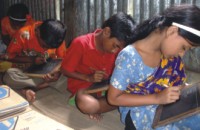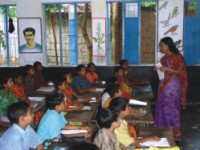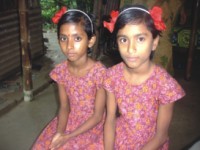|
Education Universal Primary Education in Bangladesh
Addressing the Challenges
Rebecca Terzeon
Mohammed Ali has been headmaster of Nobagram primary school since 1979. Today, the school provides an education for nearly 300 children, aged six to ten. Housed in a solid brick building, the classrooms are kitted out with basic furniture and decorated with brightly coloured wall paintings. Ali is satisfied that he has the teaching resources and materials that he needs. There is one teacher for every 50 children and textbooks are provided by the government.
 Behind the scenes, however, there are problems. The teachers explain to me that on a day during the harvesting season, they will arrive to see class sizes severely diminished. The national curriculum is outdated and its content holds little relevance for the lives of the students. While the government provides text books, pupils must bring their own stationery and other materials, which they often can't afford. Homework is often not completed and many students do not pass the exams which are set three times a year to monitor their progress. The future prospects of the children, particularly the girls, are limited. The few students who do want to go on to secondary education cannot look to the government - 96 per cent of secondary schools are private. Under these circumstances, there seems little incentive to attend school at all. Behind the scenes, however, there are problems. The teachers explain to me that on a day during the harvesting season, they will arrive to see class sizes severely diminished. The national curriculum is outdated and its content holds little relevance for the lives of the students. While the government provides text books, pupils must bring their own stationery and other materials, which they often can't afford. Homework is often not completed and many students do not pass the exams which are set three times a year to monitor their progress. The future prospects of the children, particularly the girls, are limited. The few students who do want to go on to secondary education cannot look to the government - 96 per cent of secondary schools are private. Under these circumstances, there seems little incentive to attend school at all.
Nobagram school is typical of a government primary school in Bangladesh. A high drop out rate and low attendance - due to the costs of sending a child to school, an irrelevant curriculum, inconvenient school hours and low achievement - are common problems. There are 20 million children of primary school age in Bangladesh and while primary education has been free and compulsory since 1993, the national drop out rate from primary schools is 32 per cent. Not surprisingly, the teachers didn't mention that low achievement can be largely put down to the low quality of education, due to the lack of teacher training. To qualify as a primary school teacher, a man must simply complete his own education up to grade 12 (age twenty). As an incentive to women, they can become primary school teachers at the end of grade 10, at the age of sixteen. And while it did not seem to be a problem for Ali, in most primary schools, achievement rates are also negatively affected by a shortage of classrooms and teachers. This means that they run shifts, teaching grades one to three from 9.00 to 12.30 and grades four and five from 12.30 to 4.00 pm. As a result, the school day in Bangladesh is one of the shortest in South Asia.
The Government of Bangladesh signed up to a commitment to Education for All in 1990  and advertisements on the importance of education, particularly for girls, can be heard on major television and radio stations and seen on billboards in the larger cities throughout the country. Stipends have replaced the provision of meals at school as an incentive for the poorest students. Forty per cent of primary school children are eligible for a stipend of 100 taka per month. The problem of a disproportionately high drop out rate among girls in secondary schools has also been addressed by a stipend for all girls who are unmarried; this has achieved an attendance rate of at least 70 per cent and a performance rate of at least 45 per cent. And the second Primary Education Development Programme (PEDP II), running from 2004 to 2009, has as objectives the provision of more classrooms and 35,000 more primary school teachers. This should allow children a longer school day and in order to encourage attendance, the Minister of Education is exploring options for reintroducing the provision of meals at school. and advertisements on the importance of education, particularly for girls, can be heard on major television and radio stations and seen on billboards in the larger cities throughout the country. Stipends have replaced the provision of meals at school as an incentive for the poorest students. Forty per cent of primary school children are eligible for a stipend of 100 taka per month. The problem of a disproportionately high drop out rate among girls in secondary schools has also been addressed by a stipend for all girls who are unmarried; this has achieved an attendance rate of at least 70 per cent and a performance rate of at least 45 per cent. And the second Primary Education Development Programme (PEDP II), running from 2004 to 2009, has as objectives the provision of more classrooms and 35,000 more primary school teachers. This should allow children a longer school day and in order to encourage attendance, the Minister of Education is exploring options for reintroducing the provision of meals at school.
Since its inception in 1972, following the liberation of Bangladesh, BRAC (formerly the Bangladesh Rural Advancement Committee) has become a multi-faceted development organisation, with an Education Programme that includes over 31,500 schools, currently educating nearly 1 million children who had either never enrolled or who had dropped out of school. They offer flexible hours which are agreed in consultation with parents; convenient locations for hard-to-reach areas; textbooks, stationery and other materials; a curriculum that the pupils can relate to and extra-curricular activities, such as dance, song, and drama. All teachers are female and teach classes of 33 pupils with a female: male gender ratio of 70: 30.
Nine year old Sonia and her 11 year old sister Asma live in the village of Dergram, north west of Dhaka, with their mother, Mahurannasa, father and two older sisters. Walking through the village early one morning, Mahurannasa explains to me that the family struggled tremendously to make ends meet until she heard about BRAC through a neighbour. She discussed her situation with the President of one of BRAC's Village Organisations and was accepted as a member. After receiving four weeks training about BRAC, her daughters were selected as students at the local BRAC primary school. Mahurannasa also became eligible for a loan under BRAC's Economic Development Programme, where she used to work as a rural artisan, making baskets from bamboo, and which she repaid in weekly instalments. The girls' father is also an artisan and goes to the market once a week to sell their wares, which fetch around 4000 taka a month. This is the family's only income.
Sonia and Asma are dressed in identical dresses ready to go to school. As we walk the  short distance to Dergram primary school, they proudly tell me that they study hard and enjoy school immensely. The curriculum that they follow, with their teacher Nazma Akhter, is adapted to the needs of rural children and focused on taking them through to further education. Both girls say that their favourite session in the school day is the extra-curricular activity. The school day lasts from 9.00 am to 1:00pm, leaving them time in the afternoon to help with the household chores and for further study. Mahurannasa is delighted with the education that her daughters are receiving. She explains that there are regular parent/ teacher meetings and that community involvement is a feature of the BRAC method. In comparison with the Government school, the teachers and curriculum are good and the girls are closely monitored and achieving above average grades. She hopes that after BRAC they will go to secondary school. short distance to Dergram primary school, they proudly tell me that they study hard and enjoy school immensely. The curriculum that they follow, with their teacher Nazma Akhter, is adapted to the needs of rural children and focused on taking them through to further education. Both girls say that their favourite session in the school day is the extra-curricular activity. The school day lasts from 9.00 am to 1:00pm, leaving them time in the afternoon to help with the household chores and for further study. Mahurannasa is delighted with the education that her daughters are receiving. She explains that there are regular parent/ teacher meetings and that community involvement is a feature of the BRAC method. In comparison with the Government school, the teachers and curriculum are good and the girls are closely monitored and achieving above average grades. She hopes that after BRAC they will go to secondary school.
This isn't to say that life is all easy in the BRAC school. The building that we enter is a corrugated iron hut with no furniture or electricity. Temperatures can reach 40 degrees Celsius. We are there in the monsoon season, and when it starts to rain heavily the students gather into the centre of the room to avoid leaks from the roof. It is hard to hear Nazma Akhter above the sound of the rain on the iron roof and almost impossible to see what is written on the blackboard when the sky clouds over. But the school day continues regardless. The focus is on providing a high quality education following a timetable which suits the local community, and a syllabus which is relevant and varied, to equip the children for a future career.
AT the end of the school day, I talk to the students about the future. Asma hopes to become a police officer and Sonia a nurse. And their classmates count among their preferred careers a doctor, nurse, policeman, pilot, journalist, scientist and local government official. These are ambitious, proud children with a mature outlook. Only two of the 33 children want to work overseas in the future. The rest, despite several of them having close relatives who have gone to Saudi Arabia and Dubai to work, say that they are determined to stay and improve the lives of the people of Bangladesh.
Ninety per cent of BRAC-educated children go on to secondary education. Later in the day I talk to a committee of teachers at a part-private, part-Government secondary school and they enthuse that the ex-BRAC students are the high achievers in any class. I meet fifteen year old Sheuly Aktar and her friend Farida Yasmin, thirteen, who both attended local BRAC primary schools. They are making good progress with their studies and hope to become a BRAC teacher and a doctor, respectively. For the time being their chances are certainly higher than the children at Nobagram or other Government schools, who may not have completed a primary education and are certainly unlikely to have continued to secondary school. The second Primary Education Development Programme and the work of the Minister of Education could be critical in redressing this balance over the next few years by introducing much needed reforms to the Government provision of education in Bangladesh.
DFID is funding the BRAC Education Programme phase IV, with a contribution of £32 million from July 2004 to June 2009. It is also co-funding the Government education system through the sector-wide Primary Education Development Programme (PEDP II), with a total financing envelope of $1.8 billion over six years; and some other smaller projects in the education sector, including the Under-privileged Children Education Programme (UCEP), where DFID is providing 30% of a total funding package of £6.18 million over three years.
Copyright
(R) thedailystar.net 2005 |
